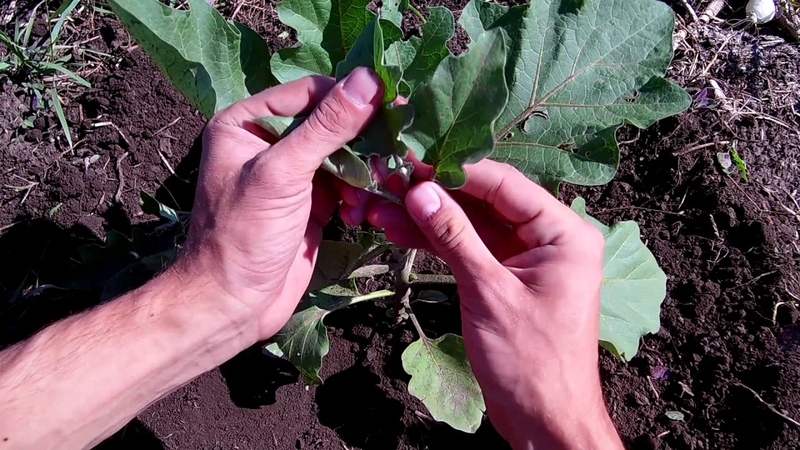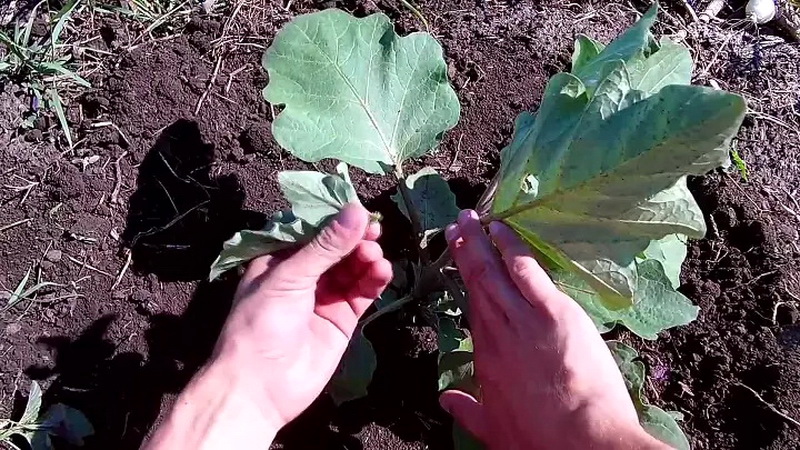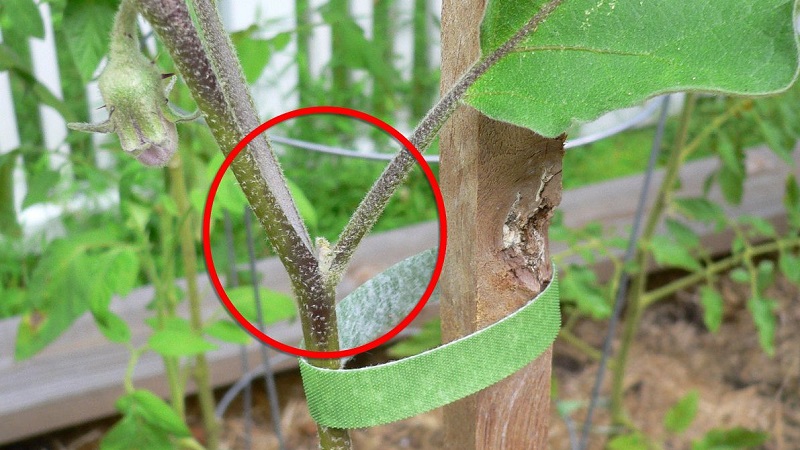When and how to pinch eggplants: a step-by-step guide for novice summer residents
For a rich eggplant harvest, you need competent and regular care for this very whimsical vegetable crop. An important component of it is pinching. Subject to the rules, the procedure stimulates the full development of the bush, strengthens its immunity and increases productivity.
The content of the article
Do I need to pinch eggplants
Grazing is the procedure for removing excess shoots so that the plant does not spend all its energy on the formation of foliage. Eliminating unnecessary stimulates formation and the growth of fruits, the quality and quantity of the crop is increased.
The procedure is necessary for eggplants growing in a greenhouse or hot humid climate. In such conditions, plants tend to produce abundant green mass and numerous lateral shoots. This threatens with low yields.
Grasshopping is not an obligatory component of caring for a vegetable crop. The procedure is not needed if:
- low-growing varieties of eggplant are grown, which are characterized by a moderate leaf mass;
- plants are grown in open field conditions when foliage is necessary to maintain soil moisture and does not interfere with the normal formation of fruits.
It is recommended to remove excess processes if the bushes create a thick shadow for each other.

What is pinching for?
Stealing gives the following results:
- bushes are formed stronger and more resistant;
- large fruits grow;
- the root area and the plant itself are well ventilated;
- increased resistance to disease.
What happens if eggplants are not pinned
If you neglect pinching in situations where it is necessary, plants will slow down their growth, they will give small and deformed fruits. There is a risk that the ovaries will not have time to ripen and will fall off.
Terms of the procedure
The procedure for removing excess shoots is resorted to on the 14-15th day after the seedlings are planted in a garden bed in open ground or a greenhouse. If the plants have taken root badly and look weakened, pinching is carried out later, on the 20th day.
Important! Eggplants are sown before buds appear.
How to pinch eggplants correctly
Passionking will give a positive effect if the first procedure is carried out in a timely manner and in compliance with the correct scheme for the formation of bushes.
On the eve of removing unnecessary processes, the plant is tied up so that the ovary that forms in large quantities does not break its stem. Experienced gardeners advise to stretch a wire over the tops of the bushes. Plants are tied to it with twine under each of their branches.
Important! Grasshopping is not done on dry or rainy days in order to protect plants from possible diseases caused by infection.
What is needed
A tool is not needed to remove small green parts of the bush. The manipulation is done manually so as not to injure the plants. Large branches are removed with pruning shears.
Attention! The place of the cut after the procedure must be treated with slaked lime.
Step-by-step instruction

The algorithm of actions depends on the pinning scheme. Solanaceae are stepchild, forming a bush from one or more stems.
The instructions for a single-stem pinching scheme include the following steps:
- Pinching the top of the stem when it reaches 30 cm in height.
- Elimination of the upper shoots after the lateral ones grow (leave 1 ovary each).
- Removal of extra leaves and stepchildren on each branch, performed once a week.
- Removing flowers, tops, small ovaries 30 days before the onset of cold weather - this stimulates the formation of large fruits.
The step-by-step instructions for pinching according to a scheme involving the creation of a two-stem bush consists of the following actions:
- Pinching the tops when the bush reaches a height of 30 cm.
- Selection of 2 strong stepchildren to be left behind.
- Removing the smaller of the 2 branches where the stem bifurcates.
- Removing excess fruits. 1 fruit is left on each shoot.
If it is hot and damp, remove the lower stepsons to protect the bush from fungal and viral damage. In drought, shoots close to the ground are left.

Eggplants growing in a greenhouse are stepsons, following step-by-step instructions:
- Ovaries and shoots are removed in the area of the lower 4 nodes.
- They trim the ears of the stepsons in the zone from 5 to 7 knots.
- Pinch the shoots, keeping 1 leaf each with an ovary, in the area from 8 to 10 knots.
- Pinch the side shoots, keeping 2 leaves with ovaries, from 11 knots to the end of the branch.
You can leave 3 ovaries on the bush. The rest is removed.
Application of pinning schemes
A single-stem scheme for the formation of a bush is used if tall varieties of eggplant are grown in cramped conditions. The procedure is aimed at leaving the strongest branch for the formation of ovaries. The 1-stem scheme is also used if the plants are weakened. They are regularly examined, leaving only the largest ovaries, on which large and tasty fruits will appear.
The scheme involving the formation of a bush from 2 stems is more popular. When the bush reaches the required height, pinch the growing point and leave 2 strong branches coming from the fork. Eliminate other shoots. From the forming ovaries, they leave full-fledged ones, they get rid of the rest, as well as from yellowed, unnecessary leaves.
Multi-stem designs are similar to 2-stem designs. Their difference lies in the fact that a few more strong stepsons are left on the bush.
Important! The pinching scheme for each bush is selected individually.
Nuances of pinching in the greenhouse and in the open field

Eggplants of medium and tall varieties growing in a greenhouse are stepchild when the plants reach a height of 35 cm.
The procedure is performed step by step:
- The bushes are examined. Well-established and developing plants grow stepchildren.
- Select a scheme for each bush.
- Eliminate unnecessary shoots according to the selected scheme.
Greenhouse plants are stepchild in the morning. It is important to keep track of whether each remaining stem is sufficiently well lit. It is unacceptable that the shoots and ovary remaining after pinching are shaded.
Eggplants growing in a greenhouse must be tied to ceiling structures. Tying up, they try not to pull the twine too tightly. Keep in mind that as it grows, the stem will increase in diameter.
Reference. You can do without tying and pinching by growing in a greenhouse eggplant varieties, not growing more than 40 cm in height.
Tall eggplants growing in open ground need pinching on the 15th day after planting in the garden. When the bush reaches a height of 35 cm, the top is pinched to it. Removal of stepchildren and unnecessary leaves is carried out according to the chosen scheme in the morning or evening hours.
Useful Tips
To get a positive effect from pinching, follow the rules:
- Plants are hand-picked. It is undesirable to use scissors. If there is a need to use the instrument, it is pre-disinfected.
- Pinch off shoots and leaves from each bush, after washing your hands with soap and water.Otherwise, there is a risk of transferring the infection from a diseased bush to a healthy one.
- A weakened plant cannot be pinned.
- In dry climates, the lower leaves are not eliminated. They help the soil retain moisture.
- Be sure to remove deformed leaves and ovaries.
- If the lower leaves have been removed more than necessary, the soil around the bush is mulched to protect it from drying out.
Common mistakes

When growing and pinching eggplant bushes, beginners in gardening may make some mistakes due to inexperience.
The most common ones are:
- Refusal to tie up a bush and remove excess leaves. This is fraught with shading of each other by plants, deterioration of high-quality lighting. Because of this, the bushes develop poorly and are more often infected with diseases.
- Incorrect tying of the bush before pinching. Correct manipulation should be carried out directly next to the bifurcation, where the most fragile part of the stem is located. The measure is necessary to protect the eggplant bushes from damage.
- Formation of bushes in too dry or rainy weather. The risk of infection by bacteria and fungi through the damaged area increases.
- Wrong time during the day for pinching eggplant bushes. The procedure is recommended to be carried out early in the morning so that the plant has time to recover by the end of the day.
- Lack of shading after pinching in the open field.
- Lack of disinfection of the working tool (secateurs) after pinching a diseased bush. This is fraught with contamination of healthy plants.
- Grazing of weak plants. This can further weaken the bush. Manipulation is postponed until the bush gets stronger.
Read also:
Do undersized tomatoes grow as children and which varieties do not require it.
Conclusion
Most varieties and hybrids of eggplant must be grazed: a significant growth of the green mass of the culture can negatively affect both the quantity and quality of the ovaries. Proper care of eggplants and the obligatory formation of tall bushes guarantee the harvest of large and fleshy fruits.